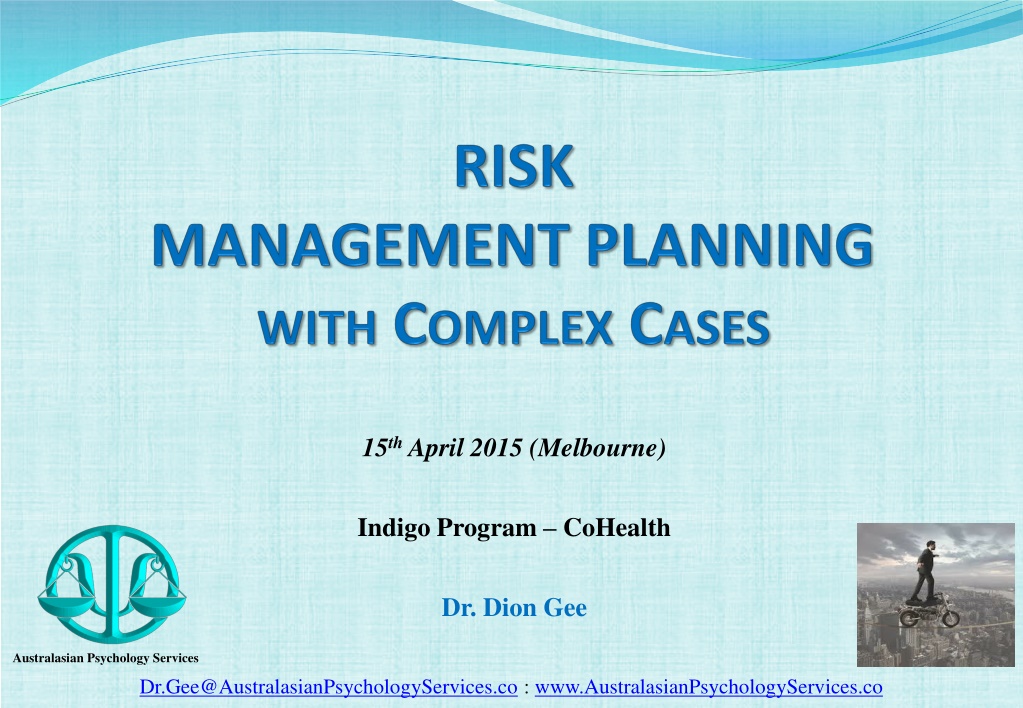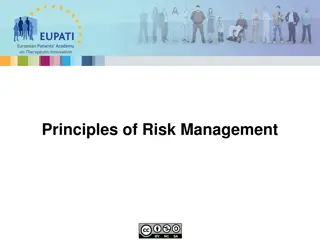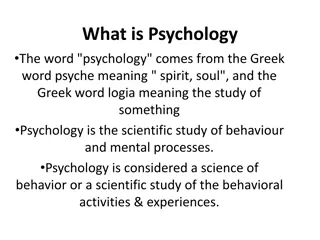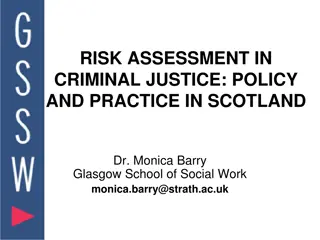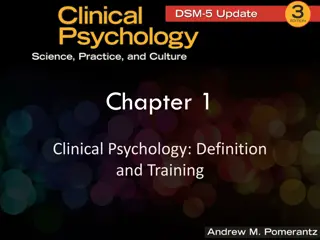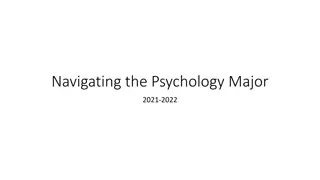Understanding Risk Assessment and Management in Psychology Practice
Exploring the systemic frameworks, language of risk, and governing legislation in the context of risk assessment and management within psychology practice. This includes a focus on conceptualizing risk, assessing potential harm, and strategies for risk mitigation to enhance client safety and well-being.
Download Presentation

Please find below an Image/Link to download the presentation.
The content on the website is provided AS IS for your information and personal use only. It may not be sold, licensed, or shared on other websites without obtaining consent from the author. Download presentation by click this link. If you encounter any issues during the download, it is possible that the publisher has removed the file from their server.
E N D
Presentation Transcript
15thApril 2015 (Melbourne) Indigo Program CoHealth Dr. Dion Gee Australasian Psychology Services Dr.Gee@AustralasianPsychologyServices.co : www.AustralasianPsychologyServices.co
I would like to take this opportunity to acknowledge the traditional owners and custodians of the land on which we meet today, the Wurundjeri people of the Kulin Nation; and pay my respects to their Elders, both past and present.
OVERVIEW Systemic Frameworks The Language of Risk The Method of Risk Risk Assessment Risk Instruments Contextualising Harm Recording Risk Risk Management Planning Communicating Risk
Systemic Frameworks The conceptual boundaries of risk!
GOVERNING LEGISLATION Disability Act 2006 Mental Health Act 2014 Children, Youth & Families Act 2005 Crimes (Mental Impairment and Unfitness to be Tried) Act 1997 Crimes Act 1958 Evidence Act 2008 Occupational Health & Safety Act 2004 Victorian Charter of Human Rights & Responsibilities Act 2006 Freedom of Information Act 1982 Residential Tenancies Act 1997
The Language of Risk The terms by which risk is conceptualised!
RISK Risk is the potential for an adverse event to lead to a negative outcome, and by assessing risk we seek to estimate how likely the event is to occur and the nature and seriousness of its impact. In this context, the adverse event is aberrant behaviour and the negative outcome is the degree and nature of harm that it causes .
HARM Harm is defined as loss, damage or personal injury. Personal injury may be of a physical or psychological nature. The aim of risk assessment is to reduce the incidence of aberrant behaviour and the harm it causes, and particularly to identify the potential for personal injury in order to prevent it. Harm may be caused by a range of behaviours.
VIOLENCE The World Health Organization defines violence as: the intentional use of physical force or power, threatened or actual, against oneself, another person, or against a group or community, that either results in or has a high likelihood of resulting in injury, death, psychological harm, mal-development or deprivation , and identifies four means by which violence may be inflicted: physical; sexual; and psychological attack; and deprivation . The key elements contributing to violence are the level of intent , the use of coercion or force , and the potential for harm to the person , whether this is realised or not.
The Method Of Risk The manner by which risk is framed!
Risk Assessment The means by which risk is understood!
THE PROCESSOF RISK ASSESSMENT Includes the identification; analysis and evaluation of the best available information, which is then communicated to inform decision making and action. The ultimate aim is reducing the likelihood and impact of future aberrant behaviour. 1. Gather and review the relevant information to identify the: Historical and current factors about the person, his or her life circumstances and behaviour that support further offending (risk factors) or desistance (strengths). Can be assisted by the application of appropriate risk tools! 2. Analyse this information: To further identify how likely further offending is in the long term and in the current context given the presence and balance of risk, strength and any identified protective factors. 3. Evaluate this analysis: Evaluate against the appropriate criteria, and the context and purpose of the assessment, and make a decision on the most appropriate course of action.
CONSIDERATIONOF RISK FACTORS Risk factors are individual characteristics that increase or decrease the probability of recidivism. Risk of harm always take into account both static (relatively unchangeable) & dynamic (changeable over time and circumstances) factors. Understanding the distinction between types of risk factors helps to appreciate their role in assessment and in their relative contribution to how, why and when offending occurs.
STATIC RISK FACTORS Historical factors that have been demonstrated to relate to recidivism potential. Are non-changeable aspects of the individual. Long term markers, and do not give a good understanding of current risk or intervention needs/treatment targets.
DYNAMIC RISK FACTORS Factors associated with offending/recidivism that are amenable to change. Can fluctuate over time. Assessment gives a better understanding of shorter term risk. Can be strengthened with supervision, and provide treatment targets for intervention.
TYPESOF DYNAMIC FACTORS Stable: Enduring changeable characteristics linked to the aberrant behavior. Acute: Rapidly changing changeable characteristics; may indicate that an aberrant behaviour will occur within a short period of time. Some factors may be both stable and acute. Require more regular re-assessment/monitoring (children/juveniles at least 6-monthly).
RISK FACTOR EXERCISE Age Dissocial Peer Substance Use Family History Intimacy problems Employment Anger Static or Dynamic Child Abuse Negative mood Prior History Victim Access Mental Illness Offence Cognitions Expressed ideation Self-regulation
SUICIDE/SELF-HARM RISK FACTORS Dynamic factors include: Static factors include: being male suicidal thoughts being young or very old availability of means to suicide (e.g., firearms, medication, substances) previous attempts or self harm feelings of hopelessness history of mental illness harmful use of substances history of childhood abuse stressful life events alcohol dependency legal problems medical illness financial problems family history of suicide poor social supports family history of mental illness impulsivity low socio-economic status interpersonal problems unemployment perceived ability to cope living in a rural area
VIOLENCE RISK FACTORS Dynamic factors include: Static factors include: a previous history of violence suicidal thoughts psychopathy treatment non-compliance substance abuse stress male gender poor family relations young age anger criminal history tendency to be impulsive childhood abuse or maladjustment thoughts about suicide violent ideation positive psychotic symptoms psychiatric ideation substance abuse psychiatric diagnoses lack of community support or supervision psychiatric symptoms
STRENGTHS Positive characteristics within the person that can make an individual more resilient to adverse events. Positive Coping, Empathy, Self-control, Secure attachment style. Predispose client towards prosocial, or encourage, non-criminal behaviour. Help to promote desistance from further aberrant behaviour. Disincline an individual from violence or aberrant behaviour due to their personal values. Not considered protective, as they do not mitigate against the risk of harm.
PROTECTIVE FACTORS Circumstances, relationships or characteristics that have a mitigating effect on the likelihood of future harm. Medication, Leisure activities, Life goals, Professionals, Living situation. Differentiated in terms of immediacy Remand in domestic violence, remove child vs. IVO or responsible adult. When present, act to prevent or interrupt an episode of potentially harmful behaviour. When absent they do not act to pose extra risk. Important in risk management, providing balance to the risk assessment, offering positive intervention goals and inspiring motivation in staff and client.
Risk Instruments The tools of the trade!
ASSESSMENT APPROACHES 1st Generation= Clinical Judgment Unstructured, non-replicable, personal discretion. Based on experience & knowledge of the literature. Non-standard (even within same institution). Level of prediction little better than chance. 2nd Generation= Actuarial Assessment Static, structured, replicable, less open to interpretation. Based on historical factors empirically related to recidivism. Standardized assessment, static - cannot measure change. Moderate levels of prediction. Unable to show change.
STRUCTURED PROFESSIONAL JUDGEMENT 3rd Generation= Dynamic Assessment Not Perfect includes dynamic and changeable items. Based on factors empirically related to recidivism. Standardized assessment of risk level and client needs. Measures change & capable of re-assessment. Still working on predictive validity. 4th Generation= Structured Professional Judgment Include identification of client s strengths. Assess client s responsivity factors. Include particular non-criminogenic needs. Stresses the integration of assessment into intervention, case planning, management, evaluation and review.
ASSESSMENT TOOLS SPJ Actuarial Risk Matrix-2000
RISK OF WHAT? Self -Harm Sexual Violence Intimidation & Threats Physical Violence Victimisation Homelessness Risk to Self Risk to Other Arson Reckless Behaviour Self-Neglect Absconding Dependents Maltreatment General Offences Drug Use Exploitation Property Damage Domestic Violence The type of assessment/instrument is governed by the nature of risk and client specific variables (e.g., age, gender, ID)
ASSESSMENT TOOLS: ADOLESCENT General Aberrant Behaviour Violent Behaviour Sexual Behaviour Self-Harm & Suicide Protective Factors Situational Environment Male YLS:CMI SAVRY PCL:YV J-SOAP-II PCL:YV ASAP-20 SAPROF:YV PRISM Female YLS:CMI SAVRY PCL:YV ASAP-20 SAPROF:YV PRISM Cognitive Impairment ARIMIDILO-G ARIMIDILO-S PRISM ARIMIDILO Early Assessment Risk List for Boys (EARL-20B -Version 2) Early Assessment Risk List for Girls (EARL-21G2)
ASSESSMENT TOOLS: ADULT General Aberrant Behaviour Violent Behaviour Sexual Behaviour Self-Harm & Suicide Protective Factors Situational Environment HCR20v3 PCL-R/SV Male LS-RNR/LSI START RSVP; SAM SARA; SRP Static-99r SBRE SRAMM SAPROF START PRISM HCR20v3 + FAM PCL-R/SV Female LS-RNR START RSVP STATIC-99r PCL-R/SV SBRE SRAMM SAPROF START PRISM ID ARMIDILO-G ARMIDILO-S PRISM ARMIDILO ID Adapted HCR-20 PCL RSVP PCL SVR-20
Contextualising Harm Mitigating environmental influence!
SITUATIONAL RISK MANAGEMENT Management of those salient and negative feature of an environment in which violence takes place. Based within the three arms of Organisational Security: Structural Security: the fences, locks, personal alarms, monitors, etc. that help keep people safe. Procedural Security: the policies and procedures in place to maintain safety and security. Relational Security: ...
RELATIONAL SECURITY Relational security is the knowledge and understanding staff have of a client and of the environment, and the translation of that information into appropriate responses and care. It is not simply about having a good relationship with a client. Safe and effective relationships between staff and clients must be professional, therapeutic and purposeful, with understood limits.
BOUNDARIES Identifying negotiable and non-negotiable boundaries. Communicating boundaries to clients and helping them understand the reasons. Being clear about the information you are going to use to make decisions. Staying aware of how you feel, how you behave and how other people interpret your behaviour. Being prepared to challenge clients and staff that violate personal boundaries. Recognising and confirming the achievement of clients when they get it right. Being prepared to talk in the team about how you feel and asking for help when you need it.
THERAPY Engaging with clients and making a commitment to treatment. Involving clients in planning their own care. Encouraging clients to believe in their own recovery and helping them to see what they can do to improve. Making sure you know what clients are learning off the unit and supporting them on the unit or helping them practice new skills. Making certain that clients care plans are up to date and relevant to their needs. Planning how to manage transition and change. Behaving as a positive role model and setting a good example.
CLIENT/PATIENT MIX Being clear about what the limits are for your unit/environment. Monitoring how clients are interacting with each other. Measuring the effect that a client arriving or leaving has on the unit/environment. Staying alert and being prepared to speak up if you have misgivings . Being prepared and knowing how to act if you need to change the mix.
CLIENT/PATIENT DYNAMICS Detecting suspicious, unusual behaviour between clients. Being aware of the dynamics on the unit and monitoring change. Encouraging clients to talk about how the unit dynamics affects them. Providing clients with a safe space to report suspicious behaviour without fear of retribution. Staying alert and ready to act and move clients if necessary. Talking about the dynamics with the team, the reasons for any change and the effect it might have on safety and security.
PERSONAL WORLD Recognising clients as people who have good days and bad days. Knowing clients histories, understand the risks associated with each client and considering possible triggers. Talking to clients sensitively about what they think their triggers are. Planning with clients how you will respond to/cope with triggers together. Staying alert and attentive to change. Communicating to the team about what you have noticed. Suicide reports pick up on changes here in retrospect.
PHYSICAL ENVIRONMENT Balance between minimising risk and having a therapeutic environment. Creating opportunities for positive social engagement. Arranging the unit so it s a space where you can observe and engage with clients. Encouraging clients to care for and take pride in their environment. Identifying areas that can be used by clients to establish dominance over others. Minimising noise and overcrowding. Giving clients the opportunity to access fresh air.
VISITORS Ensuring you know the potential risks to clients and to visitors. Preparing for and supervising visits. Talking to visitors about the effect of their visit. Encouraging visits that you know will play a positive role in a clients recovery. Detecting suspicious or unusual behaviour during a visit. Acting on any misgivings you have before, during or after a visit. Being quick to take action if something unexpected happens.
OUTWARD CONNECTIONS Developing clear management plans for when clients have leave. Being clear with clients about the non- negotiable limits and rules of contact outside the service. Acting decisively if those limits and rules are breached. Ensuring clients understand the consequences of absconding. Alert for signs of unusual behaviour that may indicate a possible abscond. Acting quickly and safely if something unexpected happens. Awareness of external responsibilities.
Recording Risk Ensuring risk is documented!
RISK STATEMENT Risk statements are a clear expression of risk in terms of the nature, seriousness, pattern and likelihood of harm. Nature: is the type of harm and possible or potential target/s. Seriousness: combines the degree of harm desired, the degree of harm intended, and the extent of planning in an episode of harm. Pattern: includes the onset, duration, frequency and escalation of harm. Likelihood: is understood as the current balance of risk and protective factors/strengths (not expressed as statistical probability). This statement is then evaluated against the relevant risk criteria for the decision at hand. Risk statements can also be evaluated against legislative and professional practice considerations.
FORMULATION Can be defined as: A theoretically-based explanation or conceptualisation of the information from a specific assessment, used to proffer an understanding of a case. The level of understanding is proportionate to the individuals age and stage of development, to the specific circumstances of the case and task at hand. When assessing the risk of harm it needs to include a hypothesis of how, why and when such aberrant behaviour might occur. It demonstrates the interaction and role of respective and relevant risk factors, (highlighting precipitating risk factors) that might identify early warning signs and indicate imminence. This level of understanding is reached through analysis and the risk formulation is seen to fundamentally link the assessment of risk with the process of risk management.
Risk Management Planning The management of uncertainty!
RISK MANAGEMENT The ultimate goal of violence risk assessment is the prevention of harm; that is, minimising the likelihood of, and negative consequences stemming from, any future violence. A process co-ordinated via the development of risk management plan! A Risk Management Plan is a shared and dynamic working document, based on a formulation or understanding of risk, in which preventative and contingency action plans show a clear link between identified risks and necessary action, those responsible for those actions, and the required communications. It is responsive to change and should outline review procedures. Risk management should always be grounded in a broader and detailed assessment of a client s social, developmental and psychological needs!
RISK MANAGEMENT PLAN A shared and dynamic working document, based on a formulation or understanding of risk, which generally incorporates a number of risk management strategies that fall into four activities: Intervention: intended to repair or restore adaptive functioning such that risk will be moderated as a consequence. Supervision strategies: to support the individual such that risk factors do not become active and protective factors dominate. Monitoring guidelines: are those aspects of a client's presentation that signify early warning signs of a relapse into violence. Victim safety planning: is a selection of strategies used with potential victims to harden them against violence in the future. Organisation security (structural, procedural, relational) has varying degrees of influence across each activity that requires consideration!
INTERVENTION Intervention and rehabilitation strategies act to instil, repair or restore adaptive functioning. Interventions are specific programmes, activities or techniques focused on changing a behaviour or treating a particular problem. The responsivity principle stresses the importance of matching interventions to an individual s characteristics (learning ability and style, motivation, personality, level of communication skills). In more complex cases there may be a range of interventions that must be co-ordinated within a plan. Consideration must be given to Medical/Psychiatric factors (medication, mental state/illness); Psychological (e.g., personality, behaviour management plans, trauma, D&A, cognitive skills, offending behaviour); Psychosocial (e.g., ADL s, good lives domains).
SUPERVISION The activity of overseeing or administering an order or condition in a manner consistent with legislation and procedures to ensure compliance. Intended to support the client such that risk factors do not become active and protective factors dominate. A means by which a relationship is established with the client, to ensure engagement through dialogue in a process of change and compliance. Either voluntary or statutory, with the principle of proportionality being kept in mind (i.e., the least restrictive measures necessary). Include rules governing potential restrictions on activity, movement, associations, communications, victim access.
MONITORING Involves observational activities intended to determine progress or deterioration, and is alert to needed changes in the plan. Is an active component of risk management and is of prime importance when managing the risk of harm. Supports contingency plans and informs response readiness to change. Includes monitoring guidelines, which are those aspects that signify early warning signs ( red flags ) of a relapse into violence. Helps identify what circumstances, occurrences, or events, should trigger a re-assessment of risk.
VICTIM SAFETY PLANNING Risk management activities where attention is drawn to the safety of specific individuals or groups who may become victims. Attempts to devise preventative or contingency strategies. Consideration of past victimology is of critical importance. A client may be both a victim and perpetrator of aberrant behaviour. Target hardening involves increasing victim resilience toward future impacts of harm or violence. May include self-protective behaviours, personal boundaries, safe space, formal communication, training, education, clinical supervision, and relational security.
